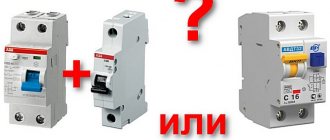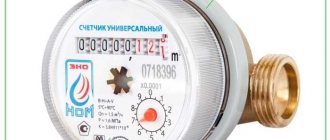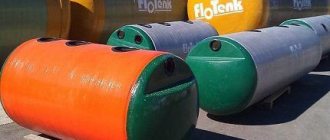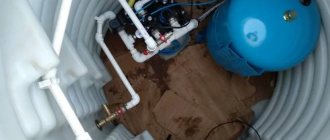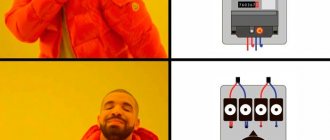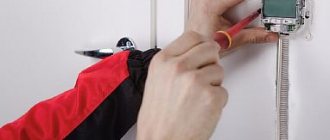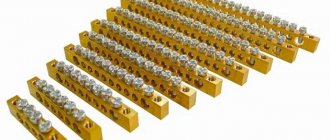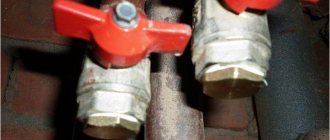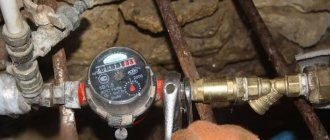In any case, it is impossible to do without protective elements of the electrical network in the apartment and in the country. These devices not only prevent serious consequences in the event of a short circuit and protect against exceeding permissible loads in the network, but also prevent current leakage. In most cases, circuit breakers, or “circuit breakers,” are used to protect devices from the consequences of a short circuit, while residual current devices (RCDs) are used to protect against possible leaks.
At the same time, both are well solved by combined devices, which have a mathematical name - differential circuit breakers, or “differential circuit breakers”. These are very convenient devices that combine two functions in one housing: an RCD and a circuit breaker.
What to choose?
Experts know about the operating principle of automatic devices and RCDs. Here you cannot simply compare, talking about some device in the categories of bigger, better and stronger.
They have almost the same characteristics, if the latter also has an automatic pre-installed. This is similar to comparing a car's sets of tires for winter and summer, choosing from them the only correct option. They are needed for the same purpose, but the conditions of use are noticeably different.
First, look at the place where the equipment will be installed. There may be some minor features. For example, the shield is small, there are shortcomings in connection, and no one can cancel the financial aspect. Some criteria can be neglected, while others can be focused on.
Read here! Checking the RCD for activation: how to check it yourself at home? (instructions + video)
If basic protection of one end customer or a simple line is needed, then a difavtomat is best suited.
Features of application
As you know, it is necessary to install a protective device in an electrical circuit precisely for the purpose of protection: as a result of a power surge or other emergency situations, it turns off the power using special technologies. As a result of such an operation, the technician will have to find the cause of the shutdown, which may include either a short circuit or a current leak. In the case of using RCBOs, such reasons may not be immediately detected.
But when using the “automatic device + RCD” combination, you will immediately see: if the RCD turns off, the fault lies in a current leak, but if the circuit breaker trips, then the reason is a short circuit or line overload.
Space
Usually in modern living conditions everyone has a small energy distribution panel. It is always clogged with various additional wiring, which makes it easy to get confused. All wiring is divided into subgroups, and then power is supplied from each specific device.
If you also want to connect electrical appliances there, it will not be easy to do, especially if all the repair work has already been completed. The not-so-pleasant stage begins when all the modules need to be swapped so that new devices can finally fit in.
Everyone knows very well that an RCD does not protect wiring from overcurrents in any way. It is additionally defended with machine guns. Each additional device has its own switch. As a result, the brush takes up a lot of extra space, due to which soon nothing will fit in it.
That is why any types of automatic machines take up much less space, which leads to more flexible operation and the possibility of adding new electrical appliances.
A new topic has appeared on the market - single-module automatic machines. They are very similar in all their functions to RCBOs, that is, they have both an RCD and an automatic circuit breaker, but all this is located in one housing, which significantly frees up space.
When the RCD does not protect
The RCD will not react when a person or animal comes under voltage, but no ground fault current will occur. This case is possible when touching simultaneously the phase and neutral conductors, which are under the control of an RCD, or when completely insulated with the floor. RCD protection in such cases is completely absent. An RCD cannot distinguish the electric current passing through the body of a person or animal from the current flowing in the load element. In such cases, safety can be ensured by mechanical protection measures (full insulation, dielectric casings, etc.) or complete de-energization of the electrical device before its technical inspection.
Therefore, the RCD is always connected in series with the machine. These two devices work in pairs: one protects against leaks, the other against overloads and short circuits.
Complexity
Installation requires a certain number of minutes, and sometimes hours. Any designation on the diagram is clearly readable. One operation sometimes takes a long time. High-quality installation is always carried out using specialized tools - pliers, strippers and much more. This significantly saves your time.
If such equipment is not available, then it is better not to even start doing something yourself. It is better to give this work to a specialist; after all, we are dealing with an unsafe device for amateurs.
Machine denomination
Table of ratings of circuit breakers
On the body of any device, the rated value is indicated - the value of the maximum continuous current that passes through the device without harm. This parameter is safe for current switching.
To ensure protection of the RCD itself, it is necessary to install a circuit breaker with a rating similar to or 1 more than the rating of the device. If you have a machine with a rating of 16 A, the RCD should be about 25 A. This current reserve will be enough to prevent the flow of energy when the load increases.
The machine is triggered when a current appears 13% higher than the nominal value: a 16 A modification will operate at a current of 18 A. If the RCD rating is equal, the contacts may heat up. To select the rating of a system with several circuit breakers, you need to sum them up and select an RCD with a larger rating.
Breaking
There is no technology without problems. Everyone may experience them from time to time. The main thing is that this is found and corrected in time. Two-pole automatic machines are no exception in this regard.
A common problem occurs in thermal releases. It may stop working under any light load. This is very difficult for ordinary people without special education to identify. Therefore, almost all breakdowns are directly related to calling an electrician. There is no need to aggravate the situation on your own if you do not understand this issue.
The nuances of installing a protective device
Connecting an RCD and a breaker in a single-phase TN-C system
Connecting an RCD in an apartment or house requires compliance with several rules:
- For several groups of consumers it is necessary to install one RCD and individual circuit breakers.
- If there are several RCDs, each of them will need a zero output bus.
- The TN-C system does not need to be zeroed.
- For “wet groups” it is mandatory to install a protective device with a shutdown rating of 10 mA.
- 30 mA devices are suitable for household appliance outlets that operate with water.
- The zero terminal is located on the right side of the device and is marked with the letter N. It should not be confused with the phase (index L).
- Input can be made to the lower or upper terminals.
- The classic circuit is implemented using a top input and a bottom output.
- Each RCD requires a personal zero block to which all working neutrals are connected.
- For lines with ripple currents, type A devices are required.
You can check the health of the system by pressing the “Test” button.
A protective shutdown device is needed to protect against overloads and short circuits. Due to the lack of response to overcurrents, it is installed in combination with a difavtomat. Connection diagrams allow installation of devices in any order. The only condition is the choice of the appropriate denomination.
Finance
The cornerstone in such cases is always the financial issue. It has already ruined quite a few buyers who wanted to save money, and then were forced to pay several times more for all the damaged equipment. Almost all modern electrical appliances are quite reliable. They have guaranteed long terms of work.
- Advantages of outdoor LED lamps
What is a "Voltage Relay"?
- Anti-static bubble film
Do not forget to leave money for all installation work. This is sometimes more important than a more expensive and functional device. Why a RCBO might trip is known to any electrician. If you are familiar with electrical engineering, you can also easily distinguish that only the RCD is broken.
If you have a large and high-quality shield with free space, then you should fill it to the maximum, and not save space. Always leave in reserve, but excessive saving is also harmful.
Distribute everything into groups so that you can clearly see what belongs to what. Additional 20-30 modules there cost only about 500 rubles - this is not the place where you need to cut the budget.
Unacceptable mistakes when purchasing
The device must be connected in accordance with the specified diagram
. To buy a high-quality automatic machine, it is important to avoid mistakes:
- Installing a device with a damaged housing - dents and cracks lead to breakdowns due to displaced internal components.
- Failed test in the store - the functionality of the devices is checked at special stands.
- Selection of the device is not according to the diagram - the machine will not correspond to the likely loads and will simply burn out.
- Using wires with an inappropriate cross-section - there may be risks of short circuits and burnouts of electrical appliances.
To choose the right differential device, you will need to study the markings, technical characteristics and carry out a test right in the store.
Photos of difavtomats
The need for power grid protection
A home electrical system is a complex branched network consisting of many circuits - lighting, sockets, separate power and low-current circuits. It includes all electrical installations that have to be used daily. The simplest among them are sockets and switches.
During the operation of household electrical appliances, unforeseen situations arise, which result in the failure of individual circuits, devices, as well as accidents.
The causes of trouble are the following:
- excessive load on power lines;
- leakage currents;
- short circuits.
You can encounter overload if you use new powerful equipment in an apartment with old wiring. The cable cannot withstand the total load, overheats, melts and fails.
An excellent example of the thoughtless use of a Chinese-made extension cord without a fuse, coupled with tees. Simultaneous use of several devices on the same power line can cause melting of contacts and insulation, as well as fire
The danger of leakage currents appears when the insulation of electrical cables and devices becomes unusable, or the equipment is installed incorrectly or grounded.
If the current rises above 1.5 mA, the effects of electricity become noticeable, and more than 2 mA causes convulsions.
A short circuit that occurs due to an unintentional connection between zero and phase also leads to irreparable consequences. The result of the formation of an electric arc is the ignition of a separate section of wiring, and often surrounding objects.
To protect equipment, property, and most importantly, the life and health of residents, emergency shutdown devices are used. Without them, a modern electrical wiring system in an apartment or private house is considered inferior and dangerous.
Technical device
Structurally, difavtomats are made of dielectric material. The rear part has a special mount for installation on a DIN rail. Inside, they consist of a two-pole or four-pole switch and a differential protection module connected in series with it. This module is a differential current transformer through which zero and phase pass, thereby forming the primary winding and the control winding - the secondary winding.
